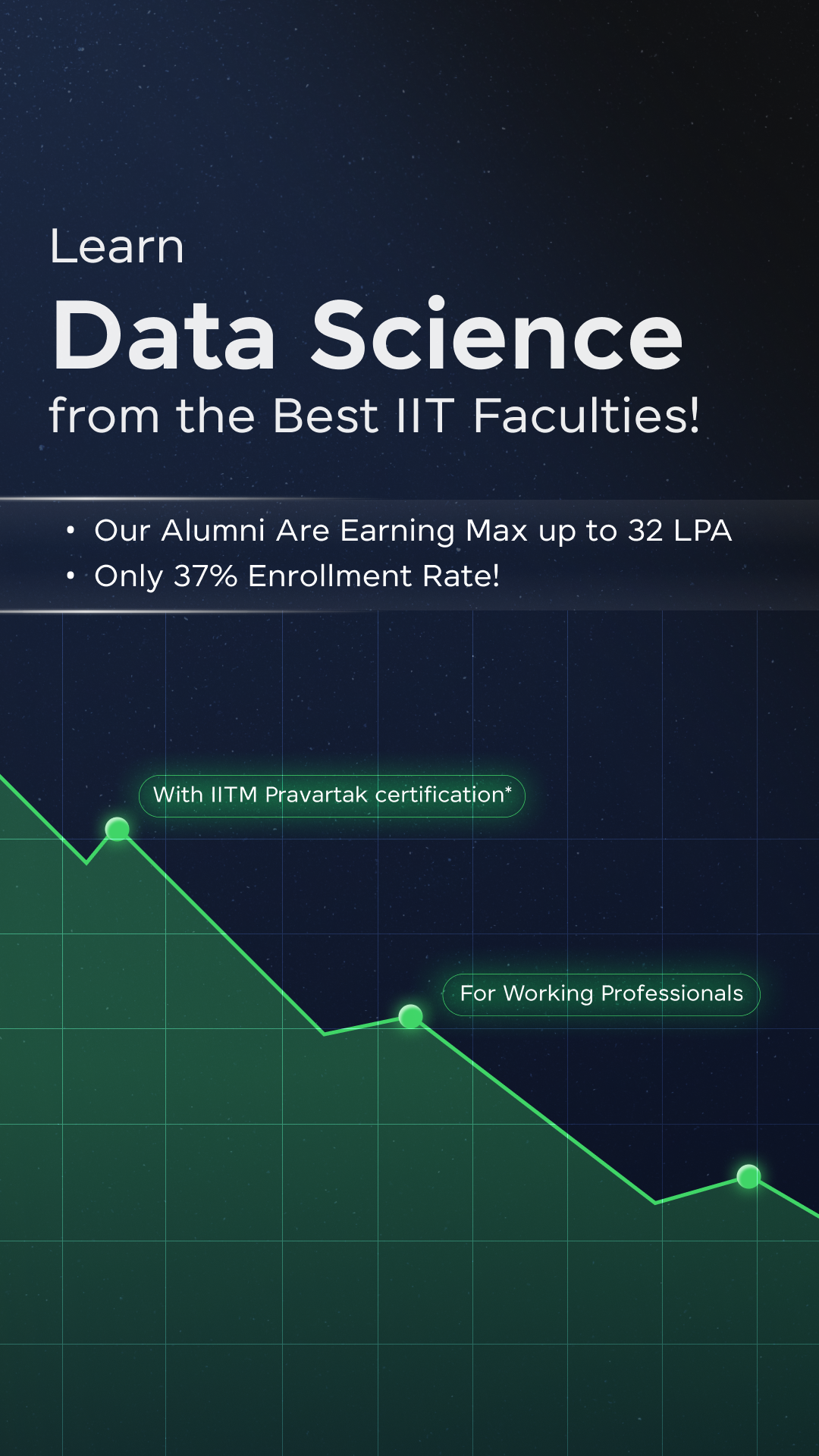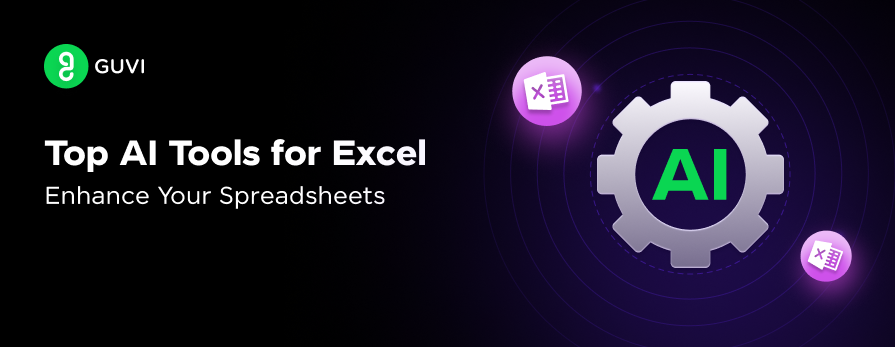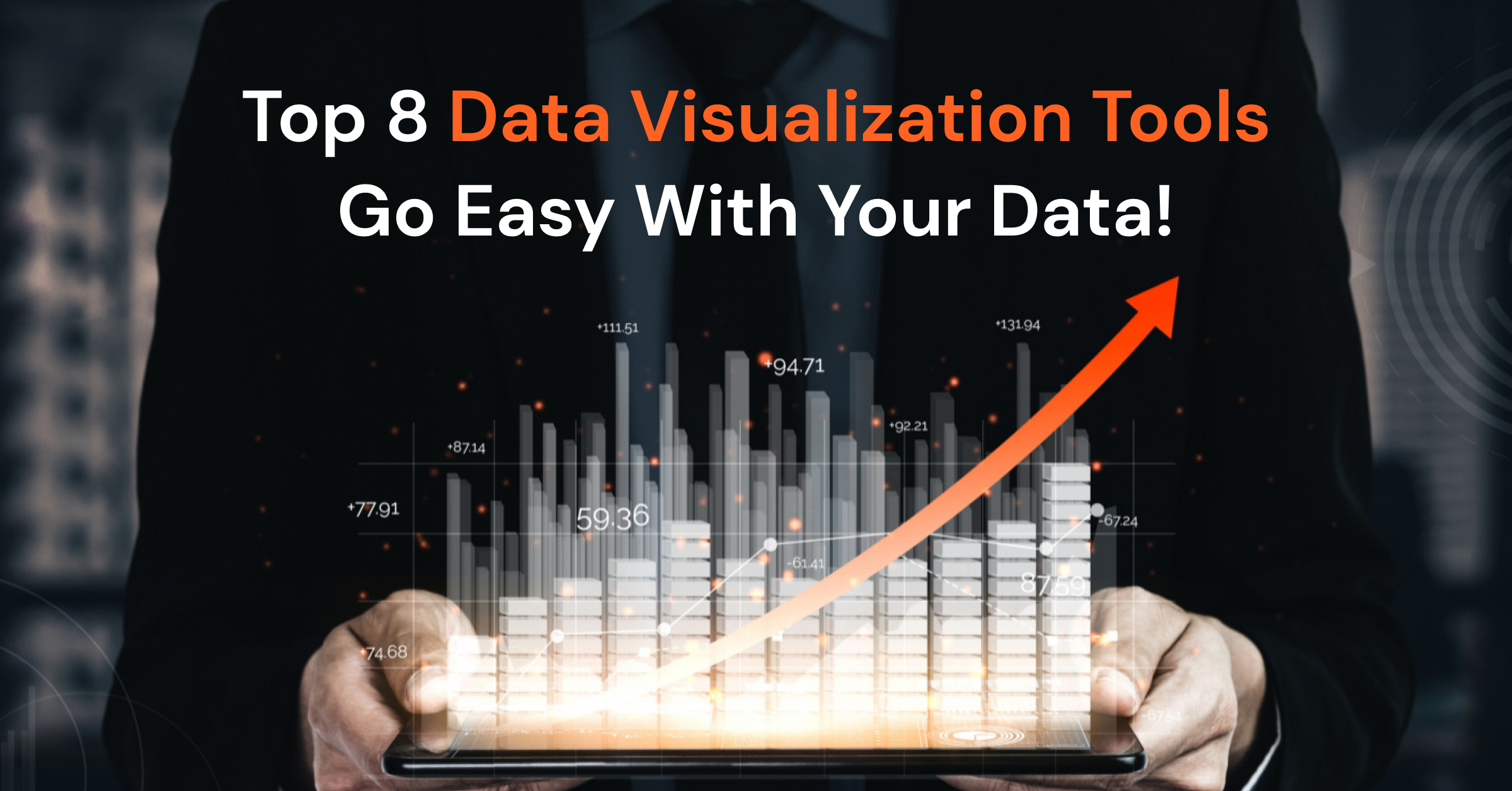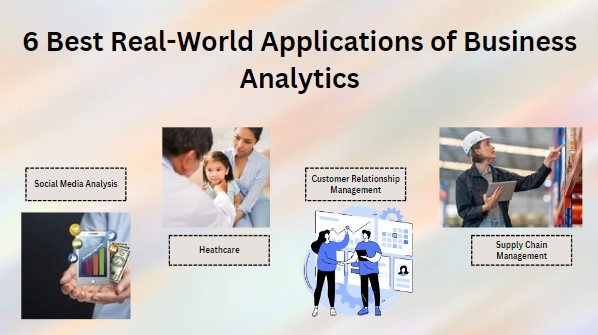
Top 8 Big Data Visualization Tools That You Should Know in 2024
Sep 05, 2024 6 Min Read 7201 Views
(Last Updated)
The world is driven by data these days. You can almost predict future events if you have the right set of data in your hands. If you are a data scientist, you can easily interpret this data but what about a layman wanting to know about the details of the data? That’s where Big Data Visualization comes in.
Big data visualization is the subject that allows you to transform data into a visual representation that can help you visualize the data. Upon hearing this, you now understand that it would be a tiresome task to do so, that’s why we will list some of the best big data visualization tools that can help you achieve this much faster.
By the end of this article, you will be equipped with the knowledge of all the big data visualization tools you would need as a data scientist to visualize the data much easier. So, without any delay, let’s get started.
Table of contents
- What is Big Data Visualization?
- Best Big Data Visualization Tools
- Microsoft Power BI
- Tableau
- SAS Visual Analytics
- Qlik Sense
- Google Data Studio
- Splunk
- D3.js
- Apache Superset
- Conclusion
- FAQs
- What is Big Data?
- Why is Big Data Visualization important?
- How does Big Data differ from Data Science?
- What are the challenges of Big Data?
- How is Big Data used in business?
What is Big Data Visualization?

It is mandatory to know about big data visualization before moving onto big data visualization tools as it is a waste if you know the advanced features without understanding the basics.
Big data visualization refers to the practice of turning large and complex datasets into visual representations, like charts, graphs, and maps. This helps in making sense of vast amounts of data by presenting it in a more understandable format so that even someone who doesn’t know much about it can understand what’s happening.
In today’s data-driven world, where data is ginormous and complex, visualization is key to uncovering patterns, trends, and insights that might be missed in raw data. It’s like translating a complex language of numbers and metrics into a visual story that’s easier to understand and interpret.
The importance of big data visualization lies in its ability to provide clarity and meaning to data that would otherwise be overwhelming. With effective visualization, businesses and organizations can make quicker and more informed decisions, as they can see and understand large datasets at a glance.
Read: Future of Data Science and How You Can Thrive With It
Before we move to the next part, you should have a deeper knowledge of data engineering concepts. You can consider enrolling yourself in GUVI’s Data Engineering Career Program, which lets you gain practical experience by developing real-world projects and covers technologies including data cleaning, data visualization, Infrastructure as code, database, shell script, orchestration, cloud services, and many more.
Additionally, if you would like to explore Data Visualization in Python through a Self-paced course, try GUVI’s Data Visualization in Python self-paced course.
Best Big Data Visualization Tools

By now, you must’ve understood the need for big data visualization and to make that job easier, we need big data visualization tools and that is what we are going to see in this section.
The best big data visualization tools are as follows:
1. Microsoft Power BI

Microsoft Power BI stands out in the world of big data visualization tools for its exceptional ability to transform raw data into meaningful insights.
As a leader among big data visualization tools, Power BI is renowned for its user-friendly interface and deep integration with other Microsoft products, making it a go-to choice for businesses already using the Microsoft ecosystem.
Some of its features include:
i) It allows users to connect to a vast array of data sources, from simple Excel spreadsheets to complex databases, and visualize this data through interactive reports and dashboards.
ii) The tool is designed to cater to both beginners and advanced users, offering a range of functionalities from basic data modeling to sophisticated analytics.
iii) The unique selling point (USP) of Power BI is its combination of powerful analytics, robust data connectivity, and affordability.
iv) It provides advanced data analytics features like quick measures, grouping, forecasting, and clustering. Users can customize dashboards and reports to fit their specific needs and share these insights across their organization with ease.
Know More | Power BI Developer in 2024: Here’s What You Don’t Know
2. Tableau

Tableau is a highly acclaimed name among big data visualization tools, celebrated for its ability to make complex data simple and understandable. As one of the most intuitive and user-friendly big data visualization tools available, Tableau empowers users to transform large datasets into visually appealing and interactive dashboards and reports.
Features of Tableau are:
i) It stands out for its drag-and-drop interface, which allows even those with minimal technical expertise to create comprehensive visualizations.
ii) Tableau’s ability to handle big data without compromising on speed or efficiency makes it a preferred choice for organizations dealing with extensive datasets.
iii) Unlike many other big data visualization tools, Tableau supports a wide range of data sources, from spreadsheets to SQL databases, and can blend different types of data for a more comprehensive view.
iv) Furthermore, Tableau goes beyond just presenting data; it enables users to explore and interact with their data, uncovering hidden insights through features like forecasting, trend analysis, and scenario planning.
3. SAS Visual Analytics

SAS Visual Analytics is a powerful tool in the list of big data visualization tools, particularly famous for its advanced analytical capabilities. This tool is part of the SAS suite, a name that comes with sophisticated data analysis.
Features of SAS Visual Analytics:
i) As a big data visualization tool, SAS Visual Analytics enables users to explore and visualize data in an interactive environment.
ii) It’s designed to cater to users of all skill levels, from data scientists to non-technical business users, making it a versatile choice for organizations.
iii) The unique selling point (USP) of SAS Visual Analytics, setting it apart from other big data visualization tools, is its strong focus on analytics-driven visualization. While many tools focus primarily on the visual representation of data, SAS Visual Analytics uses powerful statistical and analytical functions directly in its visualization.
iv) Its ability to provide in-depth insights and predictive capabilities, all within an accessible visual interface, positions SAS Visual Analytics as a standout choice among big data visualization tools for those seeking to combine visual appeal with analytical power.
4. Qlik Sense

Qlik Sense, a part of Qlik’s suite, is a prominent figure in the world of big data visualization tools, that is known for its unique approach to data analysis and visualization.
This tool stands out in this big data visualization tool list due to its associative data modeling capabilities. This feature enables users to uncover hidden trends and patterns by dynamically connecting data points across various sources.
Qlik Sense leans towards self-service data discovery, giving users the freedom to create their own visualizations with a more intuitive interface.
Qlik Sense is popular because of its in-memory data processing, which allows for faster data manipulation and analysis. This makes it incredibly efficient at handling large datasets, a critical requirement for big data applications.
Also Explore Data Science vs Data Analytics | Best Career Choice in 2024
5. Google Data Studio

Google Data Studio emerges as a user-friendly and accessible option among big data visualization tools, particularly favored for its seamless integration with other Google services.
As a web-based tool, it offers a straightforward platform for transforming data into customizable reports and dashboards.
The features of this tool include:
i) A key feature of this tool is its ability to effortlessly connect with various Google sources like Google Analytics, Google Ads, and Google Sheets, as well as non-Google data sources. This makes it an ideal choice for digital marketing professionals and businesses heavily invested in the Google ecosystem, looking to visualize and report their marketing data effectively.
ii) Google Data Studio provides a no-cost solution without compromising on essential features. It offers a range of visualization options, real-time data updates, and collaborative capabilities, allowing teams to work together on data analysis and reporting.
6. Splunk

In this list of big data visualization tools, Splunk is widely acclaimed for its ability to analyze and visualize machine-generated data.
Features of Splunk:
i) Unlike many other big data visualization tools, Splunk is tailored toward IT and security professionals, offering a powerful platform for monitoring, searching, and analyzing real-time and historical machine data. This includes data from logs, network events, and IoT devices.
ii) Splunk’s robust data indexing and searching capabilities allow users to quickly sift through massive datasets, making it an invaluable tool for operational intelligence, troubleshooting, and security analytics.
iii) Splunk is not just about creating visual representations of data; it’s about providing actionable insights from the data generated by a company’s technology infrastructure.
iv) With its powerful processing capabilities and intuitive dashboard, Splunk stands as a distinct choice in big data visualization tools, especially for businesses that prioritize IT and security operations.
7. D3.js

D3.js, short for Data-Driven Documents, is renowned for its flexibility and powerful data-driven approach. It is a JavaScript library that allows developers to create complex, interactive, and dynamic visualizations in web browsers.
This includes features like:
i) D3.js gives users complete control over the final visual output. Because of this, the tool is particularly favored by web developers and data scientists who require a high degree of customization in their data presentations.
ii) D3.js excels in rendering complex data visualizations like custom charts, graphs, and maps, all integrated seamlessly into web interfaces.
iii) This tool stands apart from others due to its deep integration with web standards, allowing users to leverage the full capabilities of modern browsers.
iv) It enables the creation of visualizations that are not only informative but also aesthetically pleasing and engaging.
The major drawback of this is that it requires a solid understanding of JavaScript and web technologies, and not everyone can use it. But its capacity to bring data to life with such minute control makes D3.js a favorite among developers and data professionals.
8. Apache Superset

Apache Superset is an emerging tool in this list of big data visualization tools, which is recognized for its open-source status and comprehensive data exploration capabilities.
As a modern data visualization platform, Superset enables users to create and share interactive dashboards and data visualizations.
This tool is designed to be highly intuitive, allowing users with varying levels of technical expertise to explore and visualize data effectively, making it a versatile option for businesses and organizations of all sizes.
The unique selling point (USP) of Apache Superset is its open-source nature, combined with its scalability and security features. Being open-source, it offers a level of flexibility and customization that is often lacking in other tools.
Users can extend and modify it to suit their specific needs, which is a significant advantage for organizations with unique data visualization requirements.
Additionally, Superset is built to handle large-scale data exploration and visualization, making it capable of catering to enterprise-level data analytics needs.
Find Out How does Apache work? A detailed introduction to Apache
With this, we come to an end of the best big data visualization tools out there and we hope you understand these in detail and can incorporate this in your daily work life.
Also Read: Top 10 Data Science Tools in 2024
Conclusion
In conclusion, the list of big data visualization tools is diverse and rich, offering solutions that cater to a wide range of needs, from simple data representation to complex, interactive analysis.
The common thread among these tools is their ability to transform overwhelming amounts of data into actionable insights through visual storytelling. As data continues to grow in size and complexity, these tools will play an increasingly crucial role in helping organizations across various industries make data-driven decisions.
Ultimately, selecting the right big data visualization tool depends on your specific requirements, data challenges, and goals. Still, the wealth of options available ensures that there’s a tool out there to meet every one of your needs.
Kickstart your career by enrolling in GUVI’s Data Engineering Career Program where you will master technologies like data cleaning, data visualization, Infrastructure as code, database, shell script, orchestration, and cloud services, and build interesting real-life cloud computing projects.
Alternatively, if you want to explore Data Visualization in Python through a Self-paced course, try GUVI’s Data Visualization in Python Self-Paced course.
Also Explore the Top 8 Data Visualization Tools- Go Easy With Your Data!
FAQs
1. What is Big Data?
Big Data refers to extremely large datasets that are difficult to manage and process using traditional data processing tools. It involves the collection, storage, analysis, and visualization of data that is voluminous and complex.
2. Why is Big Data Visualization important?
It is important because it transforms complex and voluminous data into an understandable and interpretable format, aiding in decision-making and revealing hidden patterns.
3. How does Big Data differ from Data Science?
Big Data is primarily focused on handling and processing large volumes of data, while Data Science encompasses a broader scope including data analysis, making predictions, and drawing conclusions.
4. What are the challenges of Big Data?
Challenges include data storage and processing, data quality and cleaning, data security and privacy, and the need for skilled professionals.
5. How is Big Data used in business?
In business, Big Data is used for predictive analytics, user behavior analytics, personalized marketing, and improving operational efficiency.
























![10 Impressive Data Visualization Project Ideas [With Source Code] 13 Data Visualization Project Ideas](https://www.guvi.in/blog/wp-content/uploads/2024/11/best_data_visualization_project_ideas_with_source_code_.webp)



Did you enjoy this article?